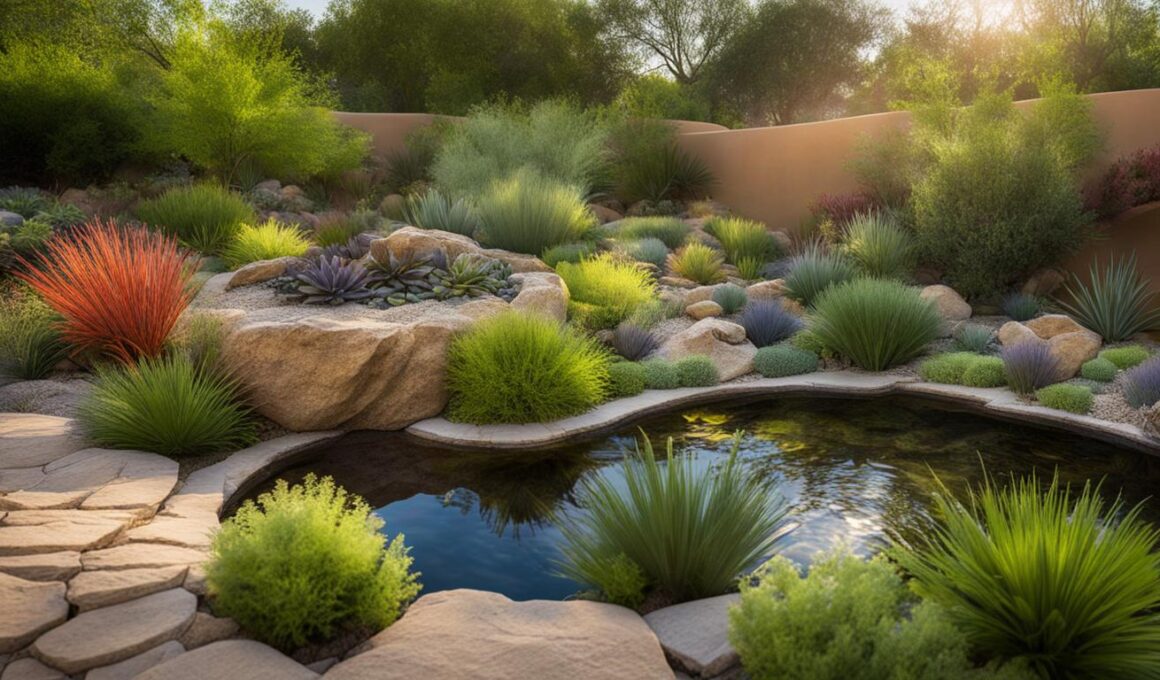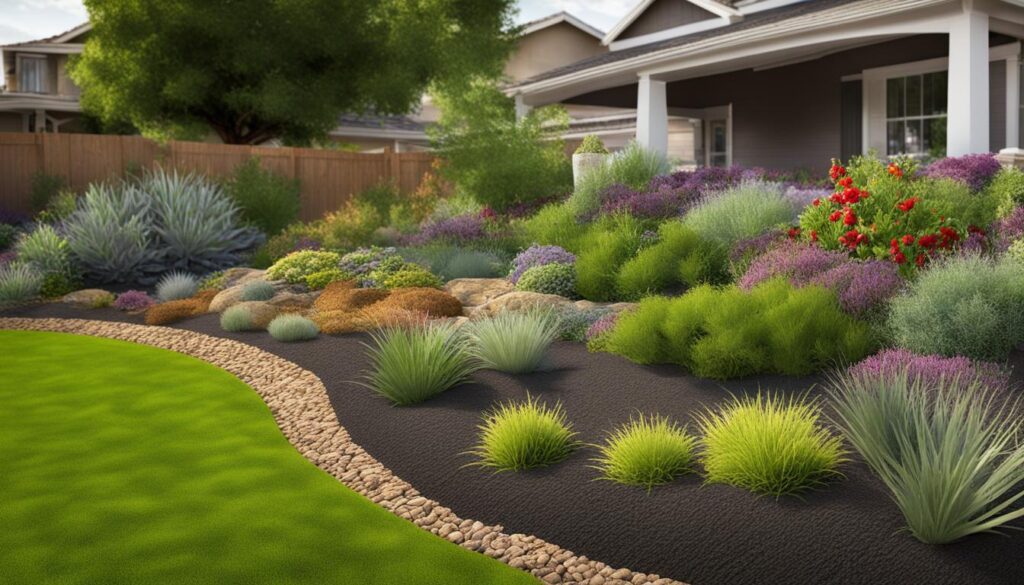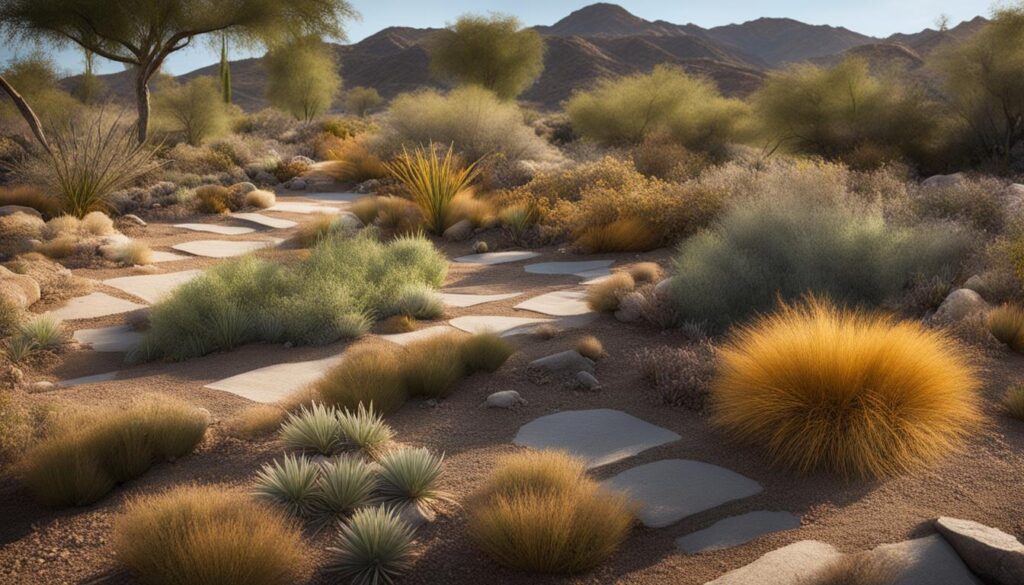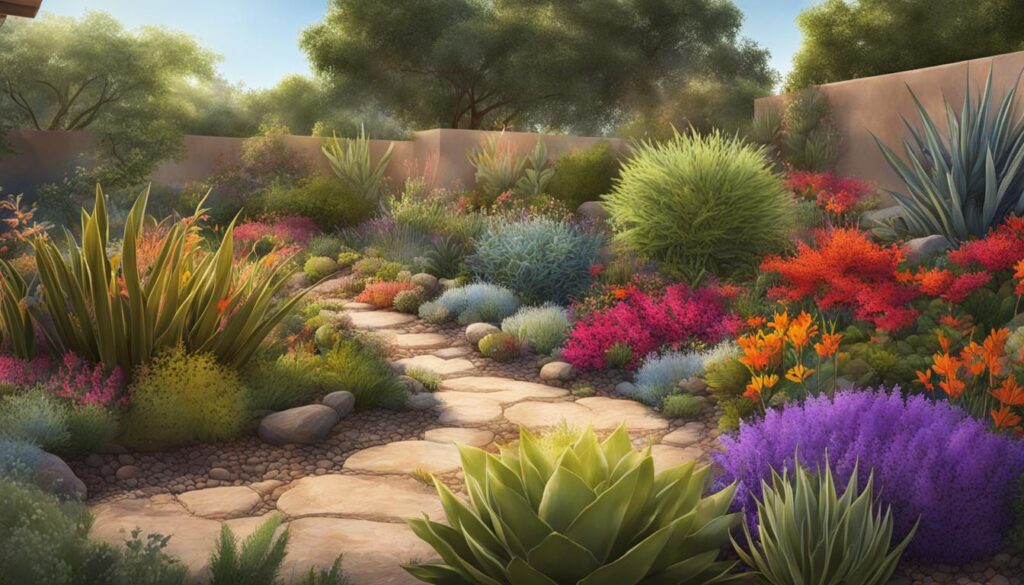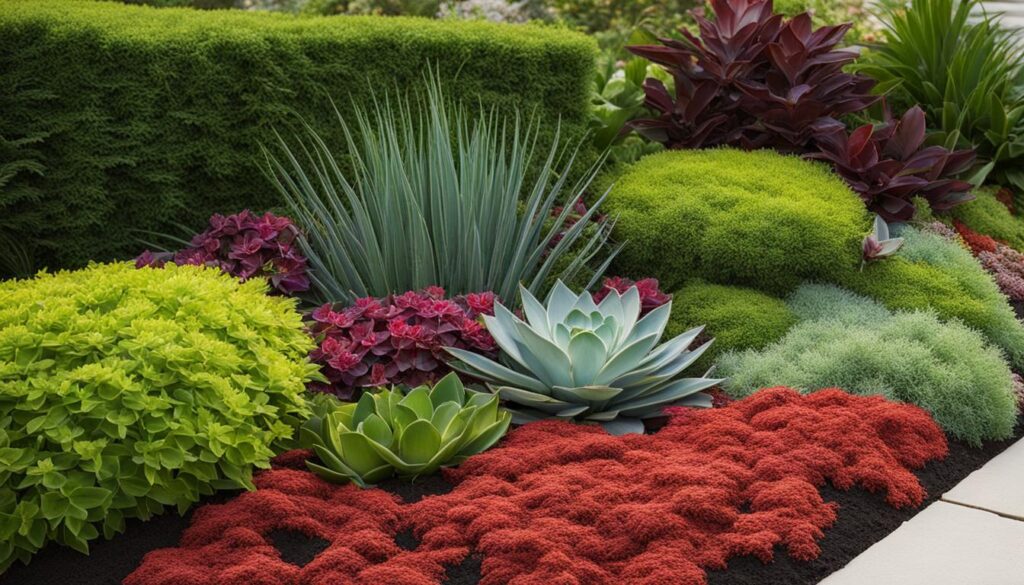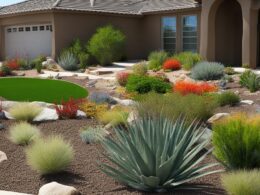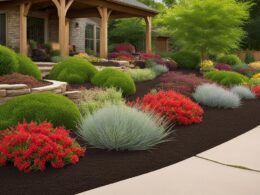Welcome to our comprehensive guide on xeriscaping benefits and how soil microbes can enhance your landscape. Xeriscaping, a water-efficient gardening method, not only helps conserve water but also promotes environmental sustainability. By incorporating soil microbes into your xeriscape garden, you can further improve its health and longevity.
Xeriscaping refers to the practice of creating a garden that requires minimal water. This is achieved by selecting drought-resistant plants, implementing efficient irrigation systems, and utilizing techniques to conserve moisture in the soil. By following the principles of xeriscaping and harnessing the power of soil microbes, you can transform your outdoor space into a thriving and eco-friendly oasis.
Throughout this guide, we will explore the core principles of xeriscaping, including water conservation, soil improvement, limited turf area, native plants, mulching, irrigation, and maintenance. We will delve into each aspect, providing you with practical tips and insights to create a successful xeriscape garden that not only benefits the environment but also enhances the beauty of your property.
Key Takeaways
- Xeriscaping is a water-efficient gardening method that conserves water and promotes sustainability.
- Soil microbes can enhance the health and sustainability of your xeriscape garden.
- The core principles of xeriscaping include water conservation, soil improvement, limited turf area, native plants, mulching, irrigation, and maintenance.
- Drought-resistant plants and efficient irrigation systems are essential components of a successful xeriscape garden.
- Mulching and proper maintenance practices help conserve moisture and promote the longevity of your xeriscape garden.
The Principles Behind Xeriscaping
Xeriscaping is a sustainable gardening practice that aims to conserve water and improve the health of the soil. By following the seven principles of xeriscaping, you can create a beautiful landscape that not only saves water but also reduces maintenance efforts. Let’s take a closer look at these principles:
1. Water Conservation
The first and most important principle of xeriscaping is water conservation. Design your xeriscape garden to minimize water use and maximize natural precipitation. This can be achieved by selecting drought-resistant plants, analyzing the drainage patterns of your land, and utilizing techniques such as terracing to reduce soil erosion. By implementing water-saving strategies, you can significantly reduce water consumption in your garden.
2. Soil Improvement
A healthy soil is essential for the success of your xeriscape garden. Soil improvement focuses on enhancing the soil’s ability to store water and drain efficiently. Increase soil organic matter by incorporating compost and other organic materials. Test your soil’s pH levels and add necessary amendments to create a nutrient-rich environment for your plants. Healthy soil helps retain moisture, promotes root growth, and supports overall plant health.
3. Limited Turf Area
Xeriscape gardens aim to minimize the use of turf areas, as lawns require significant amounts of water and maintenance. While some turf areas may be necessary for visual appeal and open space, reducing their size can greatly reduce water demand. Consider utilizing alternative ground covers or hardscaping features to reduce the reliance on turf grass, making your garden more water-efficient.
| Xeriscaping Principles | Benefits |
|---|---|
| Water Conservation | Saves water resources |
| Soil Improvement | Enhances plant health and nutrient uptake |
| Limited Turf Area | Reduces water demand and maintenance |
By following these principles, you can create a sustainable and visually appealing xeriscape garden that benefits both the environment and your property. The next sections will dive deeper into each principle, providing practical tips and techniques to implement in your own xeriscape gardening journey.
Water Conservation in Xeriscape Gardening
When it comes to xeriscape gardening, water conservation is paramount. By designing your xeriscape garden to minimize water use and make the most of natural precipitation, you can create a sustainable and eco-friendly outdoor space. There are several key strategies you can employ to reduce water consumption in your xeriscape garden.
Drought-Resistant Plant Selection
One of the most effective ways to conserve water in your xeriscape garden is by choosing drought-resistant plants. These plants are well-suited to arid climates and require minimal watering. Look for species with small, thick leaves and deep root systems, as these characteristics help the plants retain moisture more efficiently. By incorporating drought-resistant plants into your garden, you can significantly reduce the amount of water needed for irrigation.
Drainage Analysis and Terracing
Analyze the drainage patterns of your land before designing your xeriscape garden. By understanding how water flows through your property, you can make more informed decisions about where to plant and how to manage water runoff. Terracing can also be beneficial in reducing soil erosion and water wastage. By creating leveled areas or steps in your garden, you can maximize water retention and prevent excess runoff.
Smart Irrigation Techniques
When it comes to watering your xeriscape garden, it’s important to use smart irrigation techniques. Drip irrigation systems and soaker hoses are highly recommended, as they deliver water directly to the base of the plants, minimizing evaporation and runoff. It’s also crucial to adjust the watering frequency based on the water needs of different plant types. This way, you can provide adequate moisture without overwatering.
| Water Conservation Techniques | Benefits |
|---|---|
| Choosing drought-resistant plants | Reduces water consumption |
| Analyzing drainage patterns and utilizing terracing | Minimizes soil erosion and water wastage |
| Using smart irrigation techniques | Minimizes evaporation and optimizes water use |
By implementing these water conservation strategies in your xeriscape garden, you can reduce water use while still enjoying a vibrant and visually appealing landscape. Remember to regularly monitor and adjust your watering practices to ensure that your plants receive the right amount of moisture for healthy growth. With a little planning and mindful water management, you can create a thriving xeriscape garden that conserves water and supports a sustainable environment.
Soil Improvement in Xeriscape Gardening
In xeriscape gardening, soil improvement plays a vital role in creating a healthy and sustainable landscape. By enhancing the quality of your soil, you can maximize water retention, promote optimal plant growth, and minimize water runoff. Incorporating organic materials and conducting soil tests are key steps in improving the soil composition in your xeriscape garden.
Benefits of Soil Improvement
Improving the soil in your xeriscape garden has numerous benefits. It enhances water-holding capacity, allowing the soil to retain moisture for longer periods. This is especially important in arid climates where water scarcity is a concern. Additionally, improved soil structure promotes better root development, leading to healthier and more resilient plants. By enriching the soil with organic matter, you create a nutrient-rich environment that supports the overall vitality of your garden.
One effective way to improve your xeriscape garden’s soil is by incorporating organic materials such as compost, leaf litter, or well-rotted manure. These materials add essential nutrients to the soil and improve its structure, making it more conducive to plant growth. Aim to apply a layer of organic matter at least two inches thick and work it into the top few inches of soil. This helps to increase soil organic content and enhance its ability to retain moisture.
Soil Testing and Amendments
Conducting soil tests is crucial in determining the specific needs of your xeriscape garden. Test for pH levels, nutrient content, and the presence of any deficiencies or imbalances. Based on the results, you can make informed decisions about the appropriate amendments to use. For example, if your soil is acidic, you may need to add lime to adjust the pH level. If it lacks certain nutrients, you can choose targeted fertilizers or organic amendments to address the deficiencies.
Regularly monitor the health of your plants and observe any signs of nutrient deficiencies or excesses. Adjust your soil amendments accordingly to maintain optimal soil conditions for your xeriscape garden. Remember that healthy soil is the foundation of a successful xeriscape garden, enabling your plants to thrive with minimal water requirements and contributing to the overall sustainability of your landscape.
| Benefits of Soil Improvement | Soil Testing and Amendments |
|---|---|
|
|
Limited Turf Area in Xeriscape Gardening
A key principle of xeriscape gardening is minimizing the use of turf areas in your landscape. Traditional lawns not only require large amounts of water but also demand significant maintenance to keep them looking pristine. By reducing the size of your turf area, you can effectively reduce water demand and create a more water-efficient xeriscape garden.
While some turf areas may still be desired for their visual appeal or open space, it is important to consider alternative options that require less water and maintenance. Incorporating other elements such as native plants, hardscaping features, or ground covers can help diversify your landscape and enhance its aesthetic appeal.
When planning your xeriscape garden, consider the specific needs and uses of your turf areas. Optimize their functionality by locating them in high-traffic areas or places where they serve a specific purpose. By strategically placing limited turf areas and complementing them with water-efficient alternatives, you can achieve a beautiful and sustainable landscape.
The Benefits of Reducing Turf Area
Reducing the turf area not only conserves water but also offers several other benefits for your xeriscape garden:
- Lower water bills: With less turf to water, you’ll see a significant reduction in your water usage, resulting in lower water bills.
- Time and labor savings: Maintaining a smaller turf area means less time spent mowing, fertilizing, and performing other maintenance tasks.
- Increased biodiversity: By replacing turf with native plants, you create habitats for local wildlife and contribute to the overall ecological balance of your garden.
- Improved aesthetics: Incorporating a variety of plants and elements in your landscape design can add visual interest and enhance the overall beauty of your xeriscape garden.
Xeriscape Alternatives to Turf
When reducing turf area in your xeriscape garden, consider the following alternatives:
- Native plants: Choose drought-resistant native plants that are well-adapted to your region’s climate and require minimal watering.
- Hardscaping: Incorporate elements such as pathways, patios, or decorative rocks to add structure and visual appeal to your landscape.
- Ground covers: Use low-growing plants or spreading shrubs as ground covers to minimize soil erosion and add texture to your garden.
- Drought-tolerant grasses: If you still desire some green turf areas, select drought-tolerant grass species that require less water and maintenance.
| Xeriscape Alternative | Water Demand | Maintenance | Aesthetic Appeal |
|---|---|---|---|
| Native plants | Low | Low | High |
| Hardscaping | No water required | Low | High |
| Ground covers | Low | Low to moderate | Medium to high |
| Drought-tolerant grasses | Moderate | Moderate to high | High |
Native Plants in Xeriscape Gardening
When it comes to creating a drought-resistant and sustainable xeriscape garden, incorporating native plants is key. Native plants are well-adapted to the local climate and require minimal water, making them ideal choices for water-saving landscapes. By choosing native plants, you can create a beautiful and thriving xeriscape garden that not only conserves water but also contributes to the overall sustainability of your outdoor space.
Native plants have evolved to withstand the specific environmental conditions of their region, including drought periods. They have developed mechanisms to survive with limited water resources, such as deep root systems, small and thick leaves, and waxy coatings that reduce water loss through evaporation. This natural resilience makes native plants excellent candidates for xeriscape gardens, as they can thrive even in arid climates.
When selecting native plants for your xeriscape garden, consider the specific requirements of your region. Research and consult local gardening resources to identify suitable native species that are known to be drought-resistant. Some popular choices for xeriscape gardens include succulents, wildflowers, grasses, and shrubs that are indigenous to your area. By incorporating a variety of native plants, you can create a visually appealing and diverse landscape that supports local wildlife and enhances the ecological value of your garden.
By incorporating native plants into your xeriscape garden, you not only reduce water consumption but also establish a self-sustaining ecosystem that requires minimal maintenance. Native plants are adapted to the local soil and climate conditions, lowering the need for fertilizers, pesticides, and excessive watering. Additionally, native plants provide habitat and food sources for local wildlife, promoting biodiversity and ecological balance in your garden.
Creating a xeriscape garden with native plants not only benefits the environment but also enhances the aesthetic appeal of your outdoor space. The diverse colors, textures, and forms of native plants add visual interest and create a unique and vibrant landscape. Whether you’re designing a xeriscape garden in a residential backyard or a public park, incorporating native plants brings a sense of place and connection to the local ecosystem.
Mulch in Xeriscape Gardening
Mulch is an essential component of xeriscape gardening, providing numerous benefits that support the health and sustainability of your landscape. By covering the soil surface, mulch helps retain moisture, suppress weeds, and prevent soil erosion. It acts as a protective layer, shielding the soil from extreme temperatures and reducing water evaporation.
Using organic mulch materials such as wood chips, straw, or leaves can enhance the visual appeal of your xeriscape garden while serving as a natural barrier against weed growth. The dense layer of mulch inhibits weed seeds from germinating and competing with your desired plants for water and nutrients. This not only reduces the need for manual weeding but also helps maintain the overall aesthetic of your garden.
In addition to moisture retention and weed control, mulch provides insulation for the soil, regulating its temperature and preventing rapid fluctuations. This promotes a more stable environment for plant roots, allowing them to thrive and establish a strong foundation. A well-insulated soil also encourages beneficial soil microorganisms, which play a vital role in nutrient cycling and plant health.
Benefits of Mulch in Xeriscape Gardening:
- Retains moisture in the soil, reducing the need for frequent watering
- Suppresses weed growth, minimizing competition for water and nutrients
- Prevents soil erosion, maintaining the integrity of your landscape
- Insulates the soil, providing a stable environment for plant roots
- Encourages beneficial soil microorganisms, supporting plant health
By incorporating mulch into your xeriscape gardening practices, you can enhance the overall sustainability of your landscape while reducing water consumption and maintenance requirements. Remember to apply a thick layer of mulch, approximately 2-4 inches deep, around your plants, avoiding direct contact with the plant stems to prevent moisture-related diseases.
Irrigation in Xeriscape Gardening
Efficient irrigation methods are essential in xeriscape gardening to minimize water waste and ensure the health and vitality of your plants. By implementing strategic irrigation techniques, you can maximize water conservation and create a thriving xeriscape garden.
The Benefits of Efficient Irrigation
Efficient irrigation not only minimizes water consumption but also promotes strong root development and plant growth. By delivering water directly to the base of the plants, you can ensure that water is efficiently utilized and minimize evaporation. This targeted approach helps plants establish deep root systems, making them more resilient during periods of drought.
Drip-Irrigation Systems and Soaker Hoses
One of the most effective irrigation methods for xeriscape gardening is the use of drip-irrigation systems or soaker hoses. These systems deliver water slowly and directly to the root zone, reducing water loss through runoff or evaporation. Drip irrigation is particularly beneficial for plants with specific watering needs, as it allows you to tailor the amount and timing of water delivery.
Watering Frequency and Plant Needs
It’s important to adjust the frequency of watering based on the water needs of different plant types in your xeriscape garden. Native plants and drought-resistant species typically require less frequent watering once established, while new plantings may need more frequent irrigation initially. Regularly monitor soil moisture levels and observe the condition of your plants to determine their specific watering requirements.
By implementing efficient irrigation methods and adjusting watering practices based on the needs of your xeriscape garden, you can conserve water while maintaining a lush and vibrant landscape.
Maintenance in Xeriscape Gardening
Keeping your xeriscape garden well-maintained is crucial to ensure its long-term success and beauty. With proper maintenance, you can control weeds, preserve soil moisture, and promote the overall health of your plants. Here are some essential maintenance practices to consider for your xeriscape garden:
Weed Control
One of the key maintenance tasks in xeriscape gardening is weed control. Weeds compete with your desired plants for water and nutrients, undermining the efficiency of your water-conserving garden. To keep weeds at bay, apply a thicker layer of mulch, such as wood chips or straw, around your plants. This will help smother weeds and prevent their germination. Regularly inspect your garden for any emerging weeds, and promptly remove them by hand or with a weeding tool.
Proper Mowing
If you have a limited turf area in your xeriscape garden, proper mowing is essential to maintain the health and appearance of your lawn. Set your mower blades at the appropriate height to avoid scalping the grass, which can lead to stress and increased water demand. Additionally, avoid mowing your lawn too frequently, as longer grass blades provide shade and help retain moisture in the soil.
Avoid Over-Fertilization
While fertilization is important for plant growth, over-fertilizing can disrupt the balance of nutrients in your xeriscape garden and put stress on your plants. It may also lead to excessive leaf growth, increasing water requirements. Follow the recommended fertilization schedule for your specific plants, and use organic fertilizers that release nutrients slowly over time. Conduct a soil test to determine any nutrient deficiencies and adjust your fertilization approach accordingly.
Ensure Proper Moisture Retention
Xeriscape gardens are designed to be water-efficient, but they still require proper moisture retention to support plant health. Regularly monitor the moisture levels in your soil and adjust your watering schedule accordingly. Avoid overwatering, as it can lead to root rot and other plant diseases. Consider using a moisture meter to accurately assess the moisture content in the soil. Implementing a water-efficient irrigation system, such as drip irrigation, can also help ensure that water reaches the root zone efficiently.
Maintaining your xeriscape garden may require some effort, but the rewards are well worth it. By following these maintenance practices, you can enjoy a beautiful and sustainable landscape that conserves water, reduces maintenance, and enhances the overall value of your property.
How Can Soil Aeration Improve the Benefits of Xeriscaping with Soil Microbes?
Soil aeration for xeriscaping is essential for improving the benefits of xeriscaping with soil microbes. By promoting oxygen flow and reducing compaction, soil aeration enhances the activity of beneficial microbes, leading to improved soil structure, water retention, and nutrient availability. This ultimately supports the overall sustainability of xeriscaping practices.
Conclusion
By combining xeriscaping principles with the use of soil microbes, you can create a beautiful and sustainable landscape. Xeriscaping offers numerous benefits, including water conservation, reduced maintenance, increased property value, and a habitat for wildlife. Incorporating soil microbes can enhance plant health and nutrient uptake, leading to a flourishing xeriscape garden that is both eco-friendly and visually appealing.
When you embrace xeriscaping, you not only help preserve nature’s resources but also enjoy the advantages of a low-water garden. By reducing water usage, you contribute to water conservation efforts and lower your utility bills. Furthermore, xeriscaping requires minimal maintenance, saving you valuable time and effort.
Another significant benefit of xeriscaping is the potential boost it can give to your property value. With its eco-friendly appeal and long-term cost savings, a well-designed xeriscape garden can increase the attractiveness and value of your home or business. Additionally, by creating a habitat for wildlife, you contribute to the ecological balance of your local environment.
Incorporating soil microbes into your xeriscape garden can further enhance its benefits. These beneficial microorganisms improve soil structure, nutrient availability, and plant resilience. They create a symbiotic relationship with the plants, boosting their health and overall performance.





